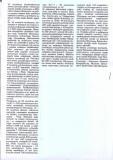| Source | Gazeta Wojenna - 1. October 1939 |
| Event referred to | City Bombing during World War II |
| Technological characteristics | Type of file: text Extension: pdf Characteristics Dimension of the file: 853 kB Availability proposed: pdf document with zoom options |
| Description of the source | Kind of the source: newspaper article
Origin of the source: Voivodship Library in Gdansk (PL)
Language: Polish
Copyright issues: reproduction and pedagogical exploitation authorized in the framework of the MHM project |
| Contextualisation of the source | “Gazeta Wojenna” was a source giving a unique information about the events which took place during the war and the time of occupation . It was giving many details and observations often from the first hand of the strategic point of view.
Its another role was to stand the Polish nation upright in its perspective and stress the role of initiated military operations.
|
| Interpretation of the source | The descriptions given by the source are very authentic and precise. They expose the global character of destroying, giving the examples of the main battle- field and more isolated however very drastic operations from the air. |
| Original Contents | Podczas agresji Niemiec hitlerowskich na Polskę we wrześniu 1939 r. lotnictwo niemieckie od samego początku stosowało terrorystyczne naloty i zbrodnicze metody wojny totalnej. Świadczą o tym masowe bombardowania otwartych polskich miast i skupisk ludności cywilnej. Za jeden z pierwszych celów bombardowania lotnicy niemieccy wybrali sobie miasto Wieluń, które w chwili wybuchu wojny liczyło 16 000 mieszkańców. 1 września miedzy godz. 4.50 a 5.30 lotnictwo niemieckie dokonało na to miasto 3 nalotów, przy czym w pierwszym z nich brało udział około 30 samolotów. Obiektem bombardowania stały się przede wszystkim: szpital, synagoga, kościół, bursa szkolna liceum męskiego, klasztor pijarski, gmach Powiatowej Komendy Uzupełnień, hotel S. Malatyńskiego oraz budynki mieszkalne na ulicach śródmieścia. W wyniku nalotów całe śródmieście ogarnięte zostało płomieniami i zamieniło się w wielkie gruzowisko. Śmierć poniosło ponad 1200 osób, a 70 % budynków zostało zniszczonych.. Legł w gruzach niemal cały dorobek tego siedmiowiekowego miasta. Bomby lotnicze zburzyły prawie wszystkie domy stojące przy Starym i Nowym Rynku. W gruzach legło kilkanaście zabytkowych kamieniczek mieszczańskich, w tym najstarszy dom mieszkalny Wielunia u zbiegu ulic Okólnej i Barycz.
W rezultacie bombardowania śmierć poniosło około 1500 osób.
Do 18 września bombowce niemieckie w nalotach na miasta i linie komunikacyjne wykonały około 5000 lotów bojowych. Obiektem szczególnie zaciekłych nalotów była zwłaszcza Warszawa. Pierwszy duży nalot, początkujący systematyczne bombardowania nastąpił 9 września, gdy bombowce nurkujące (Ju-87) wspierały natarcie 4 niemieckiej dywizji pancernej na Ochotę i wolę. Następnego dnia bombardowało stolicę 9 dywizjonów, a alarm lotniczy ogłaszano aż 17 razy. Przeprowadzano systematyczne bombardowania lotnicze, podczas których bardzo często atakowano m.in. gęsto zaludnione dzielnice, gdzie nie było żadnego obiektu o znaczeniu militarnym.
Począwszy od 20 września jednostki 1 i 4 flot powietrznych znacznie zwiększyły intensywność bombardowania Warszawy. 21 i 22 września główne uderzenia wykonały niemieckie bombowce na obiekty na obiekty prawobrzeżnej Warszawy- Pragi. Wściekłe ataki lotnicze na miasto kontynuowano i w następnych dniach. Wciągu niewielu dni zrzucono na stolicę 5818 ton bomb, a tylko podczas jej oblężenia Luftwaffe wykonała 1 176 lotów bojowych. Całodzienne kulminacyjne bombardowanie Warszawy, w którym uczestniczyło ponad 400 samolotów 9w tym 240 bombowców nurkujących) , nastąpiło 25 września, kiedy zrzucono na miasto 560 ton bomb burzących i 72 tony zapalających.
Poważną stratę materialną stanowiło zniszczenie około 12% budynków i majątku ruchomego stolicy, o wartości trudnej do oszacowania.
|
| Original Contents (English Translation) | During the Germany’s aggression on Poland in September 1939 the German air forces from the very beginning used terrorist raids and the criminal methods of the total war. There witness about it the mass bombing of the open Polish cities and the civil inhabitants’ places of living. One of the first aims of bombing was taken city Wieluń, which had 16 000 inhabitants at the time of the war starting. On the 1 September between 4.50 and 5.30 the German air forces did 3 raids on the city, including the first raid in which about 30 planes participated.
The aims of bombing were first of all: hospital, synagogue, church, school hostel, monaster, the building of the Local Command of Joining the Army, Malatynski Hotel, the falt buildings in the zone of the main city streets. As the result of the raids all the main city was covered by flames and turned into ruins. Above 1200 people were dead, and 70% of buildings were destroyed. Almost all the cultural fundaments of that city (existing since 7 centuries) was collapsed.
The bombs from air collapsed almost all the houses situated by the Old and the New Square. In the ruins there were collapsed many beautiful old houses, including the oldest living house in Wieluń at the streets Okólna and Barycz. About 1500 people suffered death because of the bombing.
Until 18th September the German bombers in the city and communication lines raids executed about 5000 battle flies. The aim especially suffering from the bombing was Warsaw. The first big raid which started the systematical bombing took place on 9th September, when the diving bombers (Ju-87) were supporting the assault of the 4th German Panzer Squadron on Ochota and Wola districts. The following day, the Polish capital was bombed by 9 squadrons, and the bomb alert was announced 17 times. There were visible systematical bombings, during which the aims were the densely lived in districts, in which there were not any objects important from military point of view. |

